Irish Plaits Cardigan |
||||||||||||||||||||||||||||
 |
 |
|||||||||||||||||||||||||||
Knitted jacket with raglan and cables on sleeves and in the sides, worked top down in DROPS Karisma or Sky. Size S-XXXL.
DROPS 173-3 |
||||||||||||||||||||||||||||
|
GARTER ST (back and forth): K all rows. 1 ridge = 2 rows K. PATTERN: See diagram A.1 (see diagram for correct size) and A.2. The diagrams show all rows in pattern seen from RS. RAGLAN: Inc for raglan before marker and 2 sts in stocking st. Inc for raglan after marker and 2 sts in stocking st. INC AS FOLLOWS FROM RS: Inc 1 st by making a YO. On next row P YOs twisted to avoid holes. INC AS FOLLOWS FROM WS: Inc 1 st by making a YO. On next row K YO twisted to avoid hole. DECREASE TIP: All dec are done from RS! Work until 4 sts remain before A.2a/A.2b, K 2 tog, K 2, work A.2a/A.2b, K 2, slip 1 st as if to K, K 1, psso. Repeat in the other side (= 4 sts dec). INCREASE TIP-1 (evenly spaced): To calculate how often inc should be done, use the total no of sts on row (e.g. 115 sts), minus bands (e.g. 10 sts) and divide the remaining sts by no of inc to be done (e.g. 11) = 9.5. I.e. in this example inc 1 st alternately approx. every 9th and 10th st (and do not inc over bands). INCREASE TIP-2: All inc are done from RS. Work until 2 st remains before A.2b, 1 YO, K 2, A.2b, K 2, 1 YO. Repeat inc in the other side = 4 sts inc on row. On next row P YO twisted to avoid holes. Then work the new sts in stocking st. SHORT ROWS: For every 10th row work short rows over the 5 sts in garter st in bands as follows (beg from RS): K 5 band sts, turn piece, tighten yarn and K back, turn piece and work as before over all sts, turn piece, K 5 band sts in garter st, turn piece, tighten yarn and K back. That way the ridges in band will not contract as much. CAST-OFF TIP: To avoid a tight cast-off edge, you may use a needle ½ size larger. BUTTONHOLES: Dec for buttonholes on right band. I.e. band at the end of row seen from WS. 1 buttonhole = K tog third and fourth st from edge and make 1 YO. Dec for buttonholes when piece measures (from cast-on edge and along the band): SIZE S: 2, 10, 18, 26, 34, 42 and 51 cm SIZE M: 2, 10, 18, 26, 35, 44 and 53 cm SIZE L: 2, 10, 19, 27, 36, 45 and 54 cm SIZE XL: 2, 11, 20, 29, 38, 47 and 56 cm SIZE XXL: 2, 11, 20, 29, 38, 48 and 58 cm SIZE XXXL: 2, 11, 20, 29, 39, 49 and 59 cm ---------------------------------------------------------- JACKET: Worked top down, back and forth on circular needle. YOKE: Cast on 115-119-123-130-134-140 sts (incl 5 band sts in garter st in each side) on circular needle size 3.5 mm with Karisma or Sky. Work 2 ridges in GARTER ST – see explanation above, then work 1 row in stocking st while inc 11-15-27-32-32-38 sts evenly – READ INCREASE TIP-1, inside 5 band sts in garter st in each side = 126-134-150-162-166-178 sts. Switch to circular needle size 4 mm and work 1 row. Now work an elevation in back of neck in stocking st as follows, beg from RS: Work until 41-43-45-48-49-50 sts remain, turn and work until 41-43-45-48-49-50 sts remain, turn and work until 36-38-40-43-44-45 sts remain, turn and work until 36-38-40-43-44-45 sts remain, turn. Continue back and forth over 5 sts more on every turn until totally 8 short rows have been worked, work the rest of row from WS. Remember BUTTONHOLES AND SHORT ROWS - see explanation above. Now work pattern as follows from RS: Work 5 band sts in garter st, stocking st over the next 16-18-20-23-24-25 sts (= left front piece), insert a marker, 2 sts in stocking st, work A.1a over the next 22-22-26-26-26-30 sts – see diagram for correct size, 2 sts in stocking st (= sleeve), insert a marker, work in stocking st over the next 32-36-40-46-48-50 sts (= back piece), insert a marker, 2 sts in stocking st, work A.1a over the next 22-22-26-26-26-30 sts, 2 sts in stocking st (= sleeve), insert a marker, work in stocking st over the next 16-18-20-23-24-25 sts (= right front piece), work 5 band sts in garter st. REMEMBER THE KNITTING TENSION Work 1 row from WS. Continue pattern like this. When the 2 rows in A.1a have been worked, repeat A.1b over A.1a, AT THE SAME TIME on next row from RS beg inc for RAGLAN – see explanation above, on each side of every marker. NOTE: Inc differently on body and sleeves. RAGLAN BODY: Inc like this every row 0-0-0-2-2-6 times, and every other row 24-26-28-28-32-32 times. Work the new sts in stocking st. RAGLAN SLEEVES: All inc are done from RS. Inc like this every other row 16-24-25-27-25-23 times, and every 4th row 4-1-1-1-4-6 times. In size S-XXL work the new sts in pattern A.1b until there is room for the entire pattern (= 30 sts). Then work the new sts in stocking st. In size XXXL work all the new sts in stocking st. When all inc are done there are 302-338-366-394-418-446 sts on needle. Piece measures 17-19-20-21-24-25 cm along band. Now work as follows from WS: Work the first 45-49-53-58-63-68 sts, slip the next 66-76-82-86-88-92 sts on a stitch holder (= sleeve), cast on 8-8-10-10-12-14 sts under sleeve, work the next 80-88-96-106-116-126 sts, slip the next 66-76-82-86-88-92 sts on a stitch holder (= sleeve), cast on 8-8-10-10-12-14 sts under sleeve, work the remaining 45-49-53-58-63-68 sts on row. BODY: There are now 186-202-222-242-266-290 sts for body. NOW MEASURE THE PIECE FROM HERE. Now work pattern as follows: Work 5 band sts in garter st, work 38-42-47-52-58-64 sts in stocking st, work A.2a (= 12 sts), work 76-84-94-104-116-128 sts in stocking st, work A.2a, work 38-42-47-52-58-64 sts in stocking st, 5 band sts in garter st. When A.2a has been worked vertically, repeat A.2b vertically over A.2a. When piece measures 4 cm, dec on each side of every repetition of A.2a - READ DECREASE TIP! Dec like this every 6th-6th-4th-4th-6th-6th row 4-4-5-5-4-4 times in total = 170-186-202-222-250-274 sts. When piece measures 13 cm in all sizes, inc 1 st in each side of A.2b - READ INCREASE TIP-2! Inc like this every other row a total of 23 times in all sizes = 262-278-294-314-342-366 sts. Continue until piece measures 34-34-34-35-34-34 cm adjust so that one whole repetition of A.2b has been worked vertically. Now inc sts evenly as follows on next row from RS: Work 5 band sts in garter st, work in stocking st over the next 57-61-65-70-77-83 sts while inc 10-11-12-12-15-14 sts evenly, work K over K and P over P over the next 12 sts, work in stocking st over the next 114-122-130-140-154-166 sts while inc 18-15-17-17-18-16 sts evenly, work K over K and P over P over the next 12 sts, work in stocking st over the next 57-61-65-70-77-83 sts while inc 10-11-12-12-15-14 sts evenly, work 5 band sts in garter st = 300-315-335-355-390-410 sts. Switch to circular needle size 3.5 mm and work 1 row. Now work rib as follows from RS: 5 band sts in garter st, (K 2, P 3) over the next 65-70-75-80-90-95 sts, K 2, work K over K and P over P over the next 12 sts, work (K 2, P 3) over the next 130-135-145-155-170-180 sts, K 2, work K over K and P over P over the next 12 sts, work (K 2, P 3) over the next 65-70-75-80-90-95 sts, K 2, 5 band sts in garter st. Continue like this back and forth until rib measures 2 cm. Now inc 1 P st in every section with 3 P = 356-374-398-422-464-488 sts. Continue with rib until rib measures 4 cm in total. Cast off with K over K and P over P - READ CAST-OFF TIP. Fasten off. SLEEVES: Worked in the round on double pointed needles. NOW MEASURE THE PIECE FROM HERE. Slip the 66-76-82-86-88-92 sts from stitch holder back on double pointed needles size 4 mm and pick up 1 st in each of the 8-8-10-10-12-14 new sts cast on under sleeve = 74-84-92-96-100-106 sts. Insert a marker in the middle of these new sts (= 4-4-5-5-6-7 new sts on each side of marker). Continue in the round with pattern A.1b over the 30 sts in the middle of sleeve and work A.2a (= 12 sts) mid under sleeve (i.e. 6 sts of pattern A.2a on each side of marker). Work remaining sts in stocking st. When A.2a has been worked vertically, repeat A.2b vertically over A.2a. When piece measures 4 cm, dec 1 st on each side of A.2b under sleeve - remember decrease tip. Dec like this every 7th-5th-4th-4th-4th-3rd round 14-18-21-22-23-25 times in total = 46-48-50-52-54-56 sts. When A.1b has been worked 6 times in total vertically (incl pattern on yoke), continue with A.1c (- see diagram for correct size). When entire A.1c has been worked vertically, continue with K over K and P over P over these sts. When piece measures 44-42-42-42-40 cm – adjust so that A.2b has been worked 1 time vertically (shorter measurements in the larger sizes because of longer yoke). Switch to double pointed needles size 3.5 mm. Now work rib, beg from the 12 sts in A.2b mid under sleeve: Work K over K and P over P over the first 12 sts (= A.2b), P 0-0-0-1-1-2, K 2-3-4-3-4-3, P 0-0-0-1-1-2, work K over K and P over P over the next 30 sts, P 0-0-0-1-1-2, K 2-3-4-3-4-3, P 0-0-0-1-1-2. When rib measures 3 cm, cast off with K over K and P over P. Fasten off. Knit another sleeve the same way. ASSEMBLY: Sew the buttons on to the left band. |
||||||||||||||||||||||||||||
Diagram explanations |
||||||||||||||||||||||||||||
|
||||||||||||||||||||||||||||

|
||||||||||||||||||||||||||||
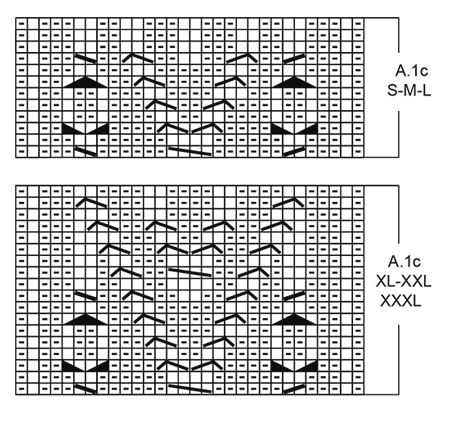
|
||||||||||||||||||||||||||||

|
||||||||||||||||||||||||||||
|
Have you made this or any other of our designs? Tag your pictures in social media with #dropsdesign so we can see them! Do you need help with this pattern?You'll find tutorial videos, a Comments/Questions area and more by visiting the pattern on garnstudio.com. © 1982-2024 DROPS Design A/S. We reserve all rights. This document, including all its sub-sections, has copyrights. Read more about what you can do with our patterns at the bottom of each pattern on our site. |
||||||||||||||||||||||||||||









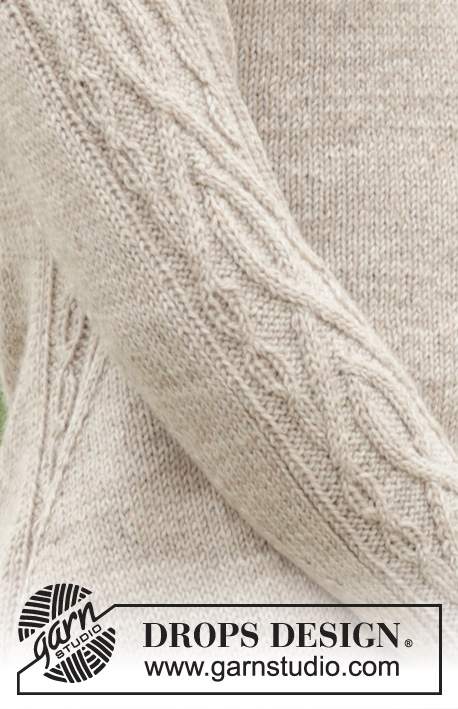
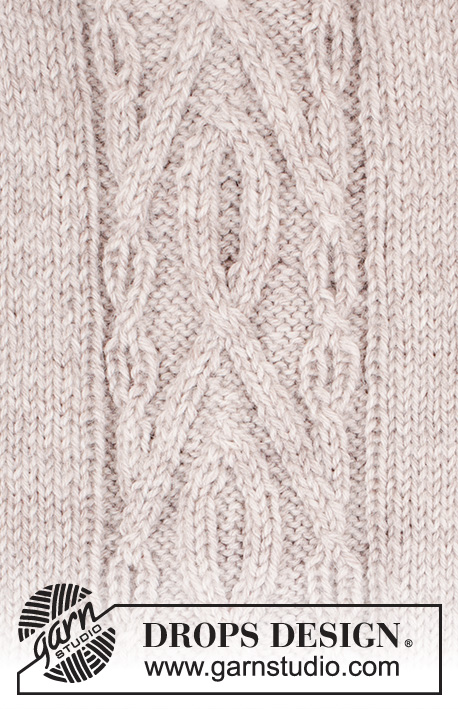


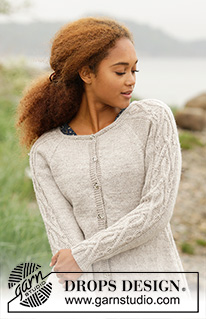

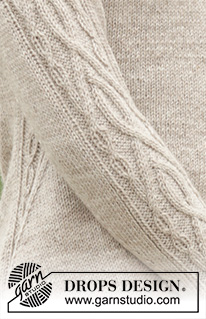

























































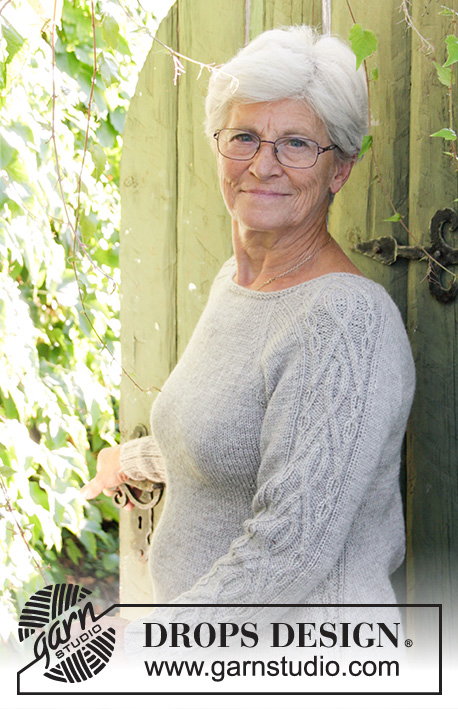







Comments / Questions (20)
Hallo, ik heb een vraag over de beschrijving helemaal in het begin. Na de ribbels voor de halsboord brei je verkorte naalden in tricotsteek. Zoals ik het begrijp begin je pas na die verkorte toeren met het telpatroon voor de kabel op de mouwen. Toch lijkt mij het resultaat dan niet wat het zou moeten zijn omdat er dan een stukje tricotsteek zit tussen de halsboord en het kabelpatroon. Wat doe ik fout? grtjs
24.11.2016 - 09:52DROPS Design answered:
Hoi Marina. Je breit zoals er staat in het patroon: halsboord, verkorte toeren en dan patroon. Zo is het model op de foto ook gebreid. Veel plezier :)
24.11.2016 - 12:36Leider passt mir das Modell gar nicht gut. Von oben nach unten gestrickte Jacken sitzen (bei mir) im Schulterbereich gar nicht gut. Dies war das zweite (und letzte) Modell für mich. Ausserdem sind mir die Ärmel im unteren Bereich viel zu eng und ich habe dünne Arme. Leider kratzt auch noch die Wolle - da kann das Modell jetzt nichts dafür. Schade, denn das Muster ist wirklich schön!
18.11.2016 - 09:39Ou alors il faut supprimer le dernier rang du diagramme pour avoir 1 seul rg de chaque côté de celui avec une maille croisée ?
17.11.2016 - 22:22Bonjour. Le diagramme A2b est étrange (motif non symétrique). Il faut tricoter le motif de médaillon (sur 5 rgs) / UN rang simple / 1 rg avec m. croisée / DEUX rangs simples / médaillon etc. Il manque 1 rang pour avoir 2 rgs autour de celui avec une maille croisée
17.11.2016 - 22:21Kann es sein, dass in Diagramm A.2b ein Fehler ist? Nach der Verzopfung werden dort 2 Reihen gestrickt, danach fängt es bei der Spreizung wieder an. Müsste es nicht nur eine Reihe sein? Das wäre konsistent mit A.2a.
26.10.2016 - 13:59DROPS Design answered:
Liebe Claudia, es gibt jetzt in neues Diagram A.2b.
31.10.2016 - 09:52Hallo! Ich habe im laufe der Zeit schon viele Ihrer schönen Anleitungen ausgedruckt. Danke dafür! Leider kann ich nach der Neugestaltung Ihrer Webseite die Anleitungen nicht mehr komplett ausdrucken. Mir fehlen immer die letzten 3 Zentimeter am rechten Rand! Haben Sie einen Tipp für mich? Danke im Voraus, Birgit Buchloh
15.10.2016 - 10:52DROPS Design answered:
Liebe Frau Buchloh, wir haben keine Änderungen für das Ausdrücken gemacht, versuchen Sie die Größe anzupassen, dh die Druckereinstellungen anpassen.
17.10.2016 - 14:21Dobrý den, možná že špatně hledám, ale nemůžu najít celkovou spotřebu příze na model S. Poradíte mi, prosím? Moc děkuji.
09.09.2016 - 06:31DROPS Design answered:
Dobrý den, spotřebu příze uvádíme v záhlaví, vpravo vedle hlavní fotky, u specifikace použité příze - pro velikost S je celková spotřeba 600 g příze Karisma. Hodně zdaru! Hana
10.09.2016 - 18:14Wanneer komen er een patronen met ingezette mouw + topdown + met ronde of v-hals in meest voor de hand liggende garens cq naalddiameters (3-4-5 mm), dat zou geweldig zijn. B.v.d. Ellis
07.07.2016 - 20:31DROPS Design answered:
Hoi Ellis. Als het gewenste patroon niet in de database staat na het zoeken, dan kunnen wij je op dit moment niet helpen.
08.07.2016 - 13:30Very pretty cardigan, elegant and simple. Love it!
20.06.2016 - 09:32Don't like the raglan near the cable, why did the designer not use the cable for a sadle-shoulder (eventuly in combinatien whith a contiguous sleevecap , if this is topdown?) so there would only be 1 line?
08.06.2016 - 23:55